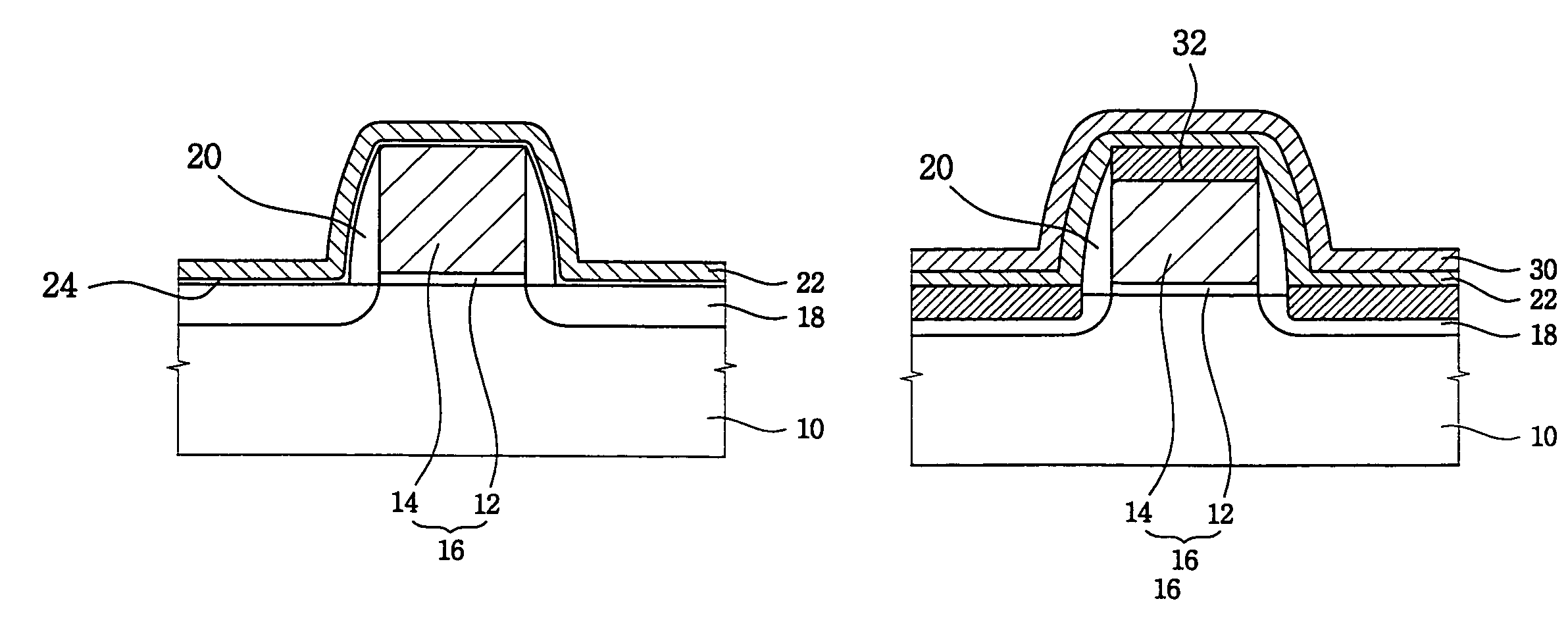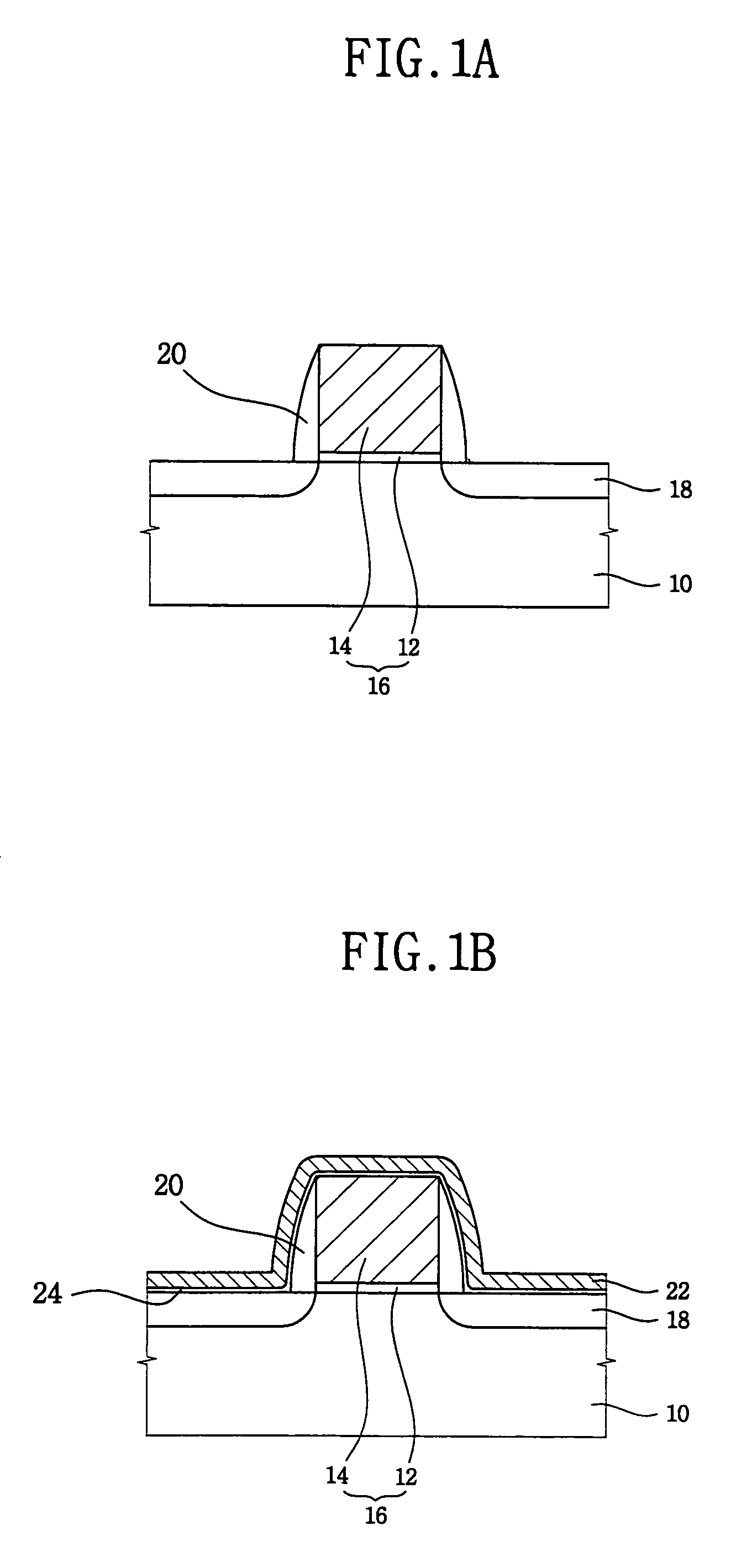Methods for forming cobalt layers including introducing vaporized cobalt precursors and methods for manufacturing semiconductor devices using the same
a cobalt layer and cobalt technology, applied in the direction of basic electric elements, electrical equipment, semiconductor devices, etc., can solve the problems of difficult operation of semiconductor devices at a high speed, unsuitable characteristics of semiconductor devices, and increase in power consumption, so as to improve the step coverage
- Summary
- Abstract
- Description
- Claims
- Application Information
AI Technical Summary
Benefits of technology
Problems solved by technology
Method used
Image
Examples
example 1
[0045]FIGS. 1A to 1F present cross-sectional views illustrating methods for forming cobalt silicide layers and semiconductor devices including the cobalt silicide layers provided herein.
[0046]Referring to FIG. 1A, a silicon substrate 10 was defined into a field region and an active region by an isolation process. A silicon oxide layer having a thickness of about 15 Å was formed on the silicon substrate 10. A polysilicon layer was then formed on the silicon oxide layer. The polysilicon layer and the silicon oxide layer were patterned to form a gate structure 16 including a polysilicon layer pattern 14 and a gate oxide layer pattern 12.
[0047]Impurities were implanted into surface portions of the silicon substrate 10 exposed by the gate structure 16 to form source / drain regions 18. A silicon nitride spacer 20 was formed on a sidewall of the gate structure 16.
[0048]Referring to FIG. 1B, the silicon substrate 10 was wet-cleaned to remove a native oxide layer and particles formed on the s...
example 2
[0062]In further methods of forming a cobalt silicide layer, a gate structure including a gate insulation layer pattern and a polysilicon layer pattern was formed on a silicon substrate. Source / drain regions were formed at surface portions of the silicon substrate at both sides of the gate structure. A silicon nitride spacer was formed on a sidewall of the gate structure.
[0063]A cobalt layer was formed on the silicon substrate and the gate structure. A cobalt precursor was vaporized and introduced onto the silicon substrate. The vaporized cobalt precursor was physisorbed and chemisorbed on the silicon substrate. A purging gas was then introduced onto the silicon substrate. The physisorbed portion was separated from the silicon substrate to leave mostly or only a cobalt atomic layer on the silicon substrate. These processes were repeatedly carried out to form the cobalt layer having a desired thickness.
example 3
[0064]FIGS. 2A to 2E present cross-sectional views illustrating a method for forming a cobalt silicide layer in a contact hole.
[0065]Referring to FIG. 2A, a polysilicon layer 102 was formed on a silicon substrate 100. An insulating interlayer 104 was formed on the polysilicon layer 102. The insulating interlayer 104 was partially etched to form a contact hole 106 exposing the polysilicon layer 104. The contact hole 106 was then cleaned using plasma.
[0066]Referring to FIG. 2B, a cobalt layer 108 was formed on the insulating interlayer 104, and a side face and a bottom face of the contact hole 106. The cobalt layer 108 can be formed as described in the present examples. A native oxide layer 110 was formed on the polysilicon layer 102 exposed through the contact hole 106 in the process for forming the cobalt layer 108.
[0067]Referring to FIG. 2C, a titanium layer 112 having a thickness of at least about 5 Å was formed on the cobalt layer 108. The titanium layer 110 can be formed by a CV...
PUM
| Property | Measurement | Unit |
|---|---|---|
| temperature | aaaaa | aaaaa |
| temperature | aaaaa | aaaaa |
| temperature | aaaaa | aaaaa |
Abstract
Description
Claims
Application Information
 Login to View More
Login to View More - R&D
- Intellectual Property
- Life Sciences
- Materials
- Tech Scout
- Unparalleled Data Quality
- Higher Quality Content
- 60% Fewer Hallucinations
Browse by: Latest US Patents, China's latest patents, Technical Efficacy Thesaurus, Application Domain, Technology Topic, Popular Technical Reports.
© 2025 PatSnap. All rights reserved.Legal|Privacy policy|Modern Slavery Act Transparency Statement|Sitemap|About US| Contact US: help@patsnap.com



